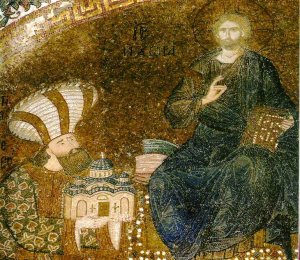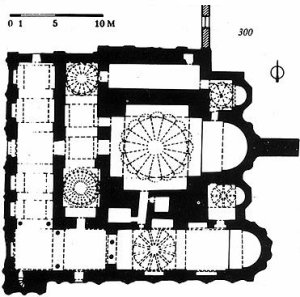Theodore Metochites (1260-1332)
Byzantine prime minister and negotiator for Emperor Andronicus II Palaeologus, one of
the principal literary and philosophical scholars of the 14th century.
 The son of George Metochites, a prominent Eastern Orthodox cleric under
Emperor Michael VIII Palaeologus and a leading advocate of union with the Latin Church,
Theodore became a favourite of Emperor Andronicus II and undertook various diplomatic
missions to enlist help against the encroaching Ottoman Turks. In a vain attempt to
reverse Byzantium's military and political decline through an alliance with Serbia,
Metochites, in 1298, led an embassy to the Serbian court at Skoplje and arranged the
marriage of Emperor Andronicus' five-year-old daughter, Simonis, to Tsar Milutin. As a
result Serbia, although militarily stronger than Byzantium, and acknowledged as ruler of
formerly Byzantine Macedonia, admitted the universal sovereignty of the Eastern emperor.
In his Presbeutikos ("Embassy Papers"), Metochites left a valuable historical
account of these negotiations as well as a concrete description of Byzantine influence on
Slavic royalty. The son of George Metochites, a prominent Eastern Orthodox cleric under
Emperor Michael VIII Palaeologus and a leading advocate of union with the Latin Church,
Theodore became a favourite of Emperor Andronicus II and undertook various diplomatic
missions to enlist help against the encroaching Ottoman Turks. In a vain attempt to
reverse Byzantium's military and political decline through an alliance with Serbia,
Metochites, in 1298, led an embassy to the Serbian court at Skoplje and arranged the
marriage of Emperor Andronicus' five-year-old daughter, Simonis, to Tsar Milutin. As a
result Serbia, although militarily stronger than Byzantium, and acknowledged as ruler of
formerly Byzantine Macedonia, admitted the universal sovereignty of the Eastern emperor.
In his Presbeutikos ("Embassy Papers"), Metochites left a valuable historical
account of these negotiations as well as a concrete description of Byzantine influence on
Slavic royalty.
 Promoted to megas logothetes ("grand logothete," or
"chancellor"), Metochites married Irene Palaeologus and, as a relative of the
ruling dynasty, directed Byzantine political affairs from 1321 to 1328, when Andronicus
fell from power. Because of his fidelity to Andronicus II, he was deprived of his wealth
and exiled by Andronicus III. In 1331 he retired to Chora Monastery (now Kariye Camii), in
Constantinople, to continue his scholarly pursuits. He directed the material and artistic
restoration of the monastery, the mosaic work of which, particularly the extant piece
showing him offering the church of Chora to an enthroned Christ, represents the acme of
14th-century Byzantine mosaic art. Promoted to megas logothetes ("grand logothete," or
"chancellor"), Metochites married Irene Palaeologus and, as a relative of the
ruling dynasty, directed Byzantine political affairs from 1321 to 1328, when Andronicus
fell from power. Because of his fidelity to Andronicus II, he was deprived of his wealth
and exiled by Andronicus III. In 1331 he retired to Chora Monastery (now Kariye Camii), in
Constantinople, to continue his scholarly pursuits. He directed the material and artistic
restoration of the monastery, the mosaic work of which, particularly the extant piece
showing him offering the church of Chora to an enthroned Christ, represents the acme of
14th-century Byzantine mosaic art.
 Metochites'
voluminous writings range from scientific to theological matters. His best-known work,
Hypomnematismoi kai semeioseis gnomikai ("Personal Comments and Annotations"),
commonly designated the "Philosophical and Historical Miscellany," is an
encyclopaedic collection of tracts and essays on classical thought, history, and
literature, comprising more than 70 Greek authors. Other treatises on physics, astronomy,
physiology, and Aristotelian psychology survive only in Latin translations. His
commentaries on the Dialogues of Plato were an important influence on the 15th-century
Platonic renaissance. Metochites'
voluminous writings range from scientific to theological matters. His best-known work,
Hypomnematismoi kai semeioseis gnomikai ("Personal Comments and Annotations"),
commonly designated the "Philosophical and Historical Miscellany," is an
encyclopaedic collection of tracts and essays on classical thought, history, and
literature, comprising more than 70 Greek authors. Other treatises on physics, astronomy,
physiology, and Aristotelian psychology survive only in Latin translations. His
commentaries on the Dialogues of Plato were an important influence on the 15th-century
Platonic renaissance.
|